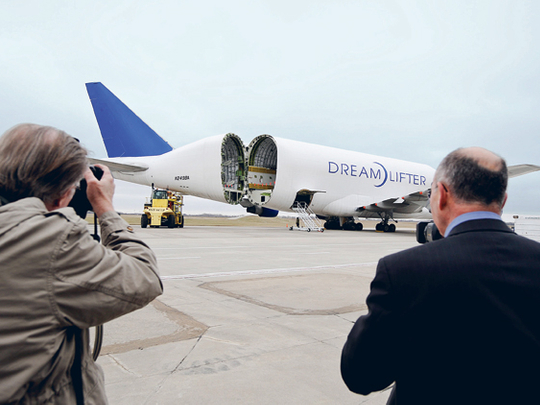
Seattle : Boeing was to conduct a "critical" wing-stress test on a parked 787 Dreamliner yesterday that would determine whether the programme can move ahead towards certification to carry passengers by year-end, following five delays.
Engineers in Boeing's Everett, Washington, factory will flex the wings, made of plastic composites, to "150 per cent of the most severe case ever expected to be seen in service," said Lori Gunter, a company spokeswoman. It's a trial required by the US Federal Aviation Administration before airlines can start flying the new jet.
A version of the test that took the wings to 100 per cent of the expected load failed last year. That delayed the Dreamliner's development by another six months as engineers strengthened spots where composite layers had separated under stress on the portion of the fuselage that meets the wing.
The 787 is the first airliner to be built with a plastic fuselage and an all-electric system and is running more than two years late, partly because of problems with the materials.
"It's an absolutely critical test in the certification process," said Hans Weber, president of San Diego-based Tecop International, who has advised the FAA. "The engineers will probably want to analyse the results more carefully than they would need to with an aluminium wing.
"This is where the composites issue comes in because it behaves differently from aluminium. You don't necessarily see the damage."
The FAA mandates that the aircraft survive three seconds of 150 per cent stress in the "ultimate load test", creating enough pressure to potentially snap the wings in two.
That's what happened with the Airbus A380 in 2006. While the breakage was a "black eye" for the Toulouse, France-based planemaker, Airbus was able to convince authorities it knew exactly what the problem was and could fix it, without having to repeat the test, Weber said.
Breaking point
In programmes past, with traditional aluminium planes, Boeing has generally passed the ultimate-load test and then taken the pressure higher until the wing does break, to see where that point is, Gunter said.
That was not planned yesterday, however, because the reinforced composite wings are expected to be stronger and would need an amount of force that's too risky to the equipment and personnel, she said.
The wings are designed to just barely pass the ultimate load test, Weber said.
"You don't want to have the wing stronger than necessary, because the stronger it is the heavier it is, and that adds to the weight of the plane," he said.
"The higher above ultimate load that it breaks, that's safety you don't need, and it's safety you pay a penalty for in terms of a less economical airplane because it's heavier than it should be."












